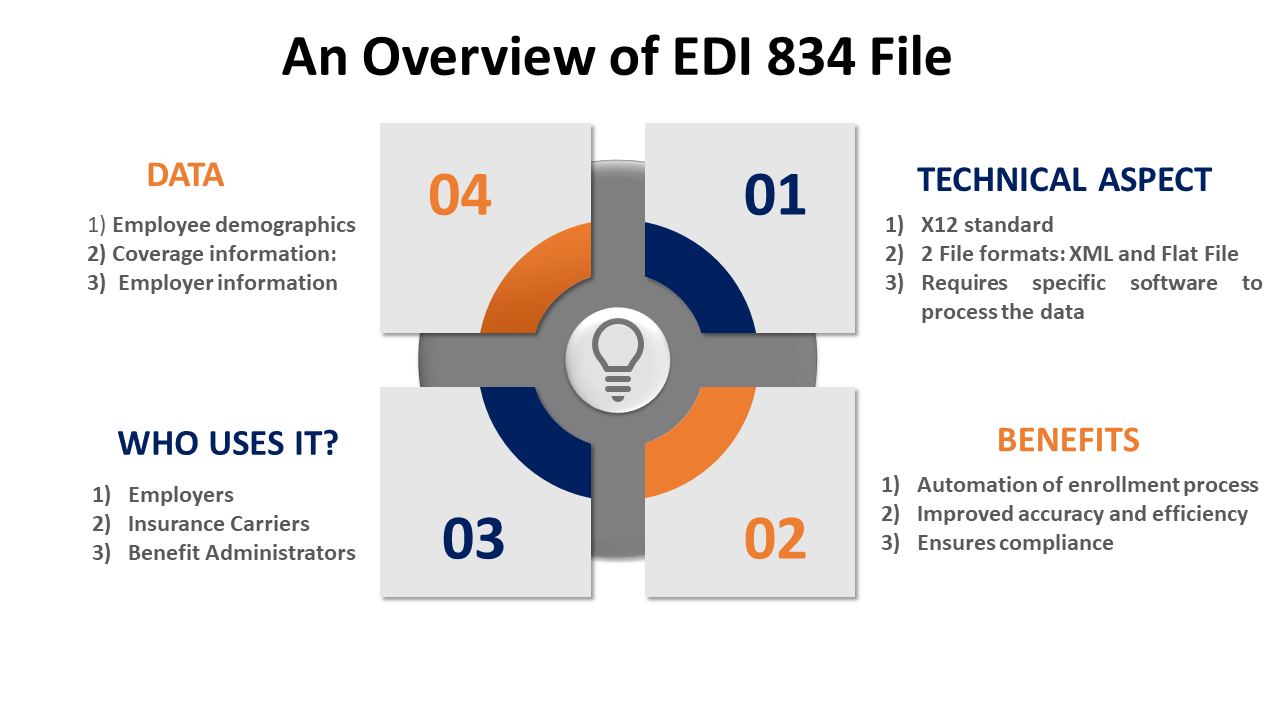Table of Contents
Benefits enrollment is a complex administrative process for businesses and insurance plans. The manual, paper-based approach is labor-intensive, time-consuming, and error-prone. However, automating this process through electronic data exchange can bring significant improvements. The 834 EDI file enables businesses and insurance plans to exchange employee enrollment data electronically, streamlining a manual process.
Adopting the standardized EDI 834 file format based on ASC X12 standards allows organizations to realize tangible benefits like faster processing, higher data accuracy, cost savings, real-time updates, seamless integration, and enhanced security. Despite the upfront investments and efforts required for implementation, the benefits of automating enrollment activities through EDI make it an important component of modern benefits management. “EDI is used by over 80% of Fortune 500 companies worldwide, indicating its established role in streamlining business-to-business communication“. Here we will discuss the significant benefits of the 834 file, best practices for implementation, and potential innovations in this important electronic transaction set.
Definition of the EDI 834 file
The 834 EDI file contains member enrollment data exchanged between health insurance plans and other entities. Consequently, the 834 EDI transaction set electronically transmits enrollment requests and changes from employers, insurance brokers, and other entities to health insurance carriers for processing. It also includes information on benefit plan selection, coverage level chosen, deductibles, copays, effective dates, and other benefit details. Insurance plans use the EDI 834 file data to set up member eligibility, assign benefits, and maintain accurate records. The 834 EDI file transaction streamlines and automates the normally manual enrollment process, reducing errors and inefficiencies.
Boost Efficiency and Compliance With Benefits Enrollment Services
Importance of the 834 EDI file in data exchange
The EDI 834 file plays an important role in automating data exchange between healthcare entities. It allows insurance plans, brokers, employers, and other organizations to electronically transmit enrollment information instead of doing it manually through paper forms. This brings several benefits:
- Speed: The EDI 834 file allows the quick and timely transfer of enrollment data. Changes can be submitted and processed within hours or days instead of weeks.
- Accuracy: Electronic data is less prone to errors than manual entry. This reduces issues like incorrect eligibility, claim denials, and refund requests.
- Cost savings: Automating the enrollment process through EDI files reduces labor, printing, and mailing costs compared to physical forms.
- Consistency: The standardized EDI 834 file format ensures data is received in a format that can be seamlessly imported and processed. There are fewer mismatches and discrepancies.
- Real-time updates: Changes submitted through the EDI 834 files can take effect immediately. Members get accurate eligibility and benefits from day one of their coverage. This improves the customer experience.
The EDI 834 file brings speed, accuracy, cost savings, and consistency to the member enrollment process through automation. It has become an indispensable part of data exchange between healthcare stakeholders.
Understanding the Structure of the EDI 834 File
The EDI 834 file has a specific structure defined by the ASC X12 standard. It consists of segments, loops, and composite elements.
- Segments: These are the basic building blocks of the file. Each segment identifies a specific data element through a three-character code. For example, the N1 segment denotes name and address information.
- Loops: Multiple segments are grouped to form loops that represent logical records. Some common loops in the EDI 834 file are Member, Dependent, and Payer.
- Composite Elements: Within segments, related data elements are grouped into composite elements identified by two character codes. For example, the DN1 segment has two composite elements – Participant Identification Code and Participant Relationship Code.
The EDI 834 file follows a specific order of loops and segments. It starts with standardized header information using the ST, BGN, HIER, and NM1 segments. Then come the member, dependent, and payer loops. The film ends with the TRA, SE, and GE trailer segments.
Properly structured EDI 834 files have:
- Consistent segment and composite element codes
- All required segments and data elements
- Segments and elements in the correct order

The Role of the EDI 834 File in Benefits Administration
EDI 834 plays an important role in the benefits administration process for employers and insurance plans. It allows electronic transmission of enrollment data between these entities, streamlining a manual paper-based process.
- Employer Role: Employers use the EDI 834 files to electronically transmit enrollment and benefits selection for new and existing employees to their insurance plans. Instead of collecting data on physical forms, employers can compile the data in their HRM system and send it via the EDI 834 file formats.
- Insurance Plan Role: Insurance plans receive the EDI 834 files from employers and use the data to set up member eligibility, assign benefits, and issue member ID cards. Having accurate enrollment data in electronic format simplifies the initial setup and ongoing maintenance of member records.
- Benefits: Using the EDI 834 files for enrollment data exchange between employers and insurance plans provides several benefits:
- Faster processing: Electronic transmission is faster than physical forms, reducing the time to activate benefits.
- Fewer errors: Electronic data contains fewer manual errors than forms. This leads to fewer issues like incorrect eligibility, claims denials, and refunds.
- Real-time updates: Changes transmitted through the EDI files can be made effective immediately in member records.
- Cost savings: Automating the benefits administration process through EDI reduces labor and mailing costs for both employers and insurance plans.
The EDI 834 file allows employers and insurance plans to transition from a labor-intensive paper-based benefits enrollment process to an electronic data exchange model. This brings speed, accuracy, and cost improvements to benefits administration.
Empower Your Employees With a Smooth Open Enrollment Process By Partnering With Us
Enhanced Data Accuracy and Integrity through EDI 834 file
The standardized EDI 834 file format ensures data is received in a consistent format with predefined segment and element codes. It thereby reduces mismatches and discrepancies compared to unstructured data. Transmitters often perform validation checks before sending the file to identify errors. The file format includes acknowledgment segments to notify transmitters of file acceptance, warnings, or rejections, allowing timely correction of errors.
After identifying errors in the processing of EDI 834, correction files can be resubmitted using segments. This will avoid inaccurate member data remaining in records. The structured electronic EDI 834 file data makes it easier for insurance plans to develop auditing rules and checks to identify anomalies, duplicates, and invalid values, improving overall integrity. Composite elements within EDI 834 file segments allow granular verification of individual data points like names, addresses, and coverage details, ensuring accuracy at the specific data element level.
All these factors- the standardized format, validation checks, acknowledgment segments, error correction process, auditing capabilities, and composite elements – enable more accurate and complete enrollment data exchange compared to unstructured data sources, ultimately leading to higher integrity of member records.
Improved Efficiency and Cost Savings through EDI 834 file
The standardized EDI 834 format allows automatic electronic processing of enrollment data instead of manual data entry from physical forms. This improves the efficiency of the benefits administration process for businesses and insurance plans in several ways. Studies say that with the use of EDI, efficiency improvement is 30% to 50%. Also, cost savings of 20-50% than manual processes
Transmitting enrollment information electronically through the EDI 834 files is faster than physical forms. It thereby reduces the time taken to activate benefits for new hires and changes for existing employees. The electronic data contains fewer errors than manual forms.
Automating the enrollment process through EDI 834 files also reduces labor costs, paper form printing costs, and mailing expenses for businesses and insurance plans compared to physical forms. By streamlining and speeding up the normally laborious manual enrollment process, the EDI 834 file helps save time and money for benefits administrators while also activating employee benefits faster and with fewer errors.
Compliance with Industry Standards through EDI 834 file
The 834 file format is based on ASC X12 standards established by the Accredited Standards Committee. These standards define the segments, elements, loops, and structure of the EDI 834 files that organizations must adhere to for compliant EDI transactions. Following the ASC X12 standards ensures that the interpretation, importation, and processing of data transmission is accurate through EDI 834 files. Not complying with the standards would mean the file is not useful.
Major entities in the healthcare industry like insurance plans, brokerages, employers, and benefits administration platforms require enrollment data in the standard EDI 834 file format for seamless integration. Organizations wishing to exchange enrollment data electronically through EDI, therefore, have no choice but to comply with the EDI 834 file specifications. The standardized format facilitates smooth, error-free communication between trading partners and reduces the need for interfacing variations.
Compliance with EDI 834 file industry standards thus allows businesses and other entities to automate their open enrollment for benefits process through a common electronic interface, integrating them into the wider workflow of the healthcare system.
Seamless Integration with Multiple Systems through EDI 834 file
Since EDI file formats are popular across the healthcare industry, organizations can exchange enrollment information electronically with a variety of trading partners through a common interface. This includes insurance plans, benefits administration platforms, payroll providers, HR departments, and other entities.
The consistent structure of EDI 834 files ensures data is received in a format that systems from different vendors can seamlessly import, parse, and integrate into their workflows. Properly formatted EDI 834 file transmissions require little to no customization or modification to interface with the receiving entity’s applications. The standardized nature of the EDI 834 transaction set facilitates plug-and-play integration between disparate systems without the need for costly, time-consuming custom interfaces.
This simplifies electronic enrollment data exchange for businesses and allows them to transmit data to multiple receivers through a single, standardized channel. The EDI 834 file format thus serves as a common electronic language for automating benefits enrollment processes across the wider healthcare ecosystem.
Real-Time Data Updates and Notifications through EDI 834 file
The EDI 834 file format allows enrollment and benefits changes submitted through these files to take effect quickly in member records, providing more up-to-date eligibility and benefits information. Since the processing & transmission of 834 files is electronic, data exchange does not depend on the physical delivery of paper forms.
Upon the validation of EDI 834 files, enrollment updates are immediately applicable to member records. This ensures employees have accurate eligibility and coverage details from the effective date of their plan choices and changes.
The ASC X12 acknowledgment segments within EDI 834 files also allow insurance plans and benefits administrators to provide real-time notifications about file acceptance, warnings, and rejections. Transmitters can be instantly notified if a file has errors requiring correction, shortening the cycle time for the resubmission of accurate data. The electronic, machine-readable nature of EDI 834 files thus facilitates near real-time updating of member information and acknowledgment of file receipt.
This provides benefits administrators and members with more current data compared to the lag times associated with mailing and manually processing physical enrollment forms. Real-time data exchange through EDI 834 file transactions improves the timeliness of benefits administration.
Data Security and Privacy Measures through the EDI 834 file
Organizations transmitting and receiving enrollment data through EDI 834 files must implement appropriate security and privacy measures. This is to safeguard the sensitive information contained within these transactions. Common practices include data encryption, secure data exchange channels, access control, and audit logging.
- Encryption: Sensitive data in EDI 834 files is often encrypted using technologies like TLS, SSL, or PGP before transmission to protect it in transit. Receivers then decrypt the files using the corresponding keys.
- Secure channels: EDI 834 files are typically exchanged over secure channels like VPNs or appropriately secured web portals to prevent unauthorized access during transfer.
- Access control: Organizations limit access to EDI 834 files and associated systems only to authorized personnel on a need-to-know basis. Different levels of access are granted based on job roles and responsibilities.
- Audit logging: All transactions involving EDI 834 files are logged and audited to detect any unauthorized access attempts. Logs are routinely reviewed to ensure policy compliance.
Proper application of these measures helps protect the member names, social security numbers, health information, and other sensitive data within EDI 834 transactions.
Organizations must comply with relevant data privacy regulations like HIPAA when transmitting electronically secure health information through the EDI 834 file format.
Adhering to EDI security best practices and regulatory requirements ensures that enrollment data exchanged remains private and secure.
Scalability and Flexibility for Growing Organizations through EDI 834 file
The EDI 834 file format provides a standardized electronic channel for exchanging member enrollment data that scales to meet the needs of growing organizations. Since the EDI 834 file transaction set is not dependent on physical forms, it can support high transaction volumes without straining resources. The standardized file structure ensures systems on both ends can reliably process higher numbers of EDI 834 files with little need for customization.
This makes electronic interfaces an ideal option for organizations undergoing rapid growth with increasing employee counts and benefit plans. The EDI 834 file format also offers flexibility in terms of accommodating changes to data elements over time. New segments, elements, and codes can be added to EDI 834 files to capture evolving requirements. Updates to the ASC X12 EDI 834 file standard are also periodic to account for industry advances.
This allows the EDI 834 framework to adapt, expand, and stay in alignment with the dynamic needs of benefits administrators. 834 EDI automates enrollment eliminating the need for unnecessary paperwork.
Challenges and Considerations in Implementing the 834 file
- Upfront costs and resources: Conforming to the 834 EDI file standard requires investments in EDI-enabled software, secure networks, training, and technical expertise. This involves upfront costs and the allocation of internal resources.
- Testing and validation: EDI 834 file data must be thoroughly tested and validated before transmission to ensure compliance with the standard. Any non-standard files are likely to be rejected.
- Transaction volumes: Organizations must have the IT infrastructure to support potential transaction volumes, especially if growing rapidly.
- Data security: Strict security policies and encryption technologies are needed to protect sensitive data within EDI 834 files.
- Vendor support: Some vendors may charge additional fees for EDI 834 file transfers or require custom implementations.
- Complexity: The EDI 834 file standard has many segments, elements, and codes. The error-free implementation requires proper understanding.
- Regulatory compliance: Organizations must comply with all relevant laws governing electronically protected health information, including HIPAA for healthcare entities.
- Change management: Transitioning from paper to electronic enrollment requires process changes, employee training, and stakeholder buy-in.
While the EDI solutions bring several benefits, implementing them successfully requires careful planning and consideration. For example, costs, resources, IT capabilities, security, vendor relationships, complexity, and regulatory compliance. A phased approach and testing of initial, limited file transfers before full production can reduce implementation risks.
Best Practices for Implementing and Managing the EDI 834 File
- Define requirements – Understand your current enrollment processes, pain points, data needs, and priorities to define clear objectives for the EDI file.
- Plan technology and security – Determine software, networks, encryption, and other technology needed. Create security policies to protect file data.
- Test file transfers – Start with a small sample of 834 files to test with trading partners before full implementation. Identify and resolve issues early.
- Train employees – Educate HR and benefits staff on the EDI 834 file format and transition from paper to electronic enrollment.
- Phase implementation – Start with a single trading partner or a subset of data before scaling to full EDI 834 file adoption.
- Monitor files – Track file volumes, acknowledgments, rejections, and errors. Develop processes to resolve issues and resend corrected files.
- Audit data regularly – Perform routine audits to detect anomalies, incorrect values, or duplicates within EDI 834 file data.
- Keep updated – Check for new versions of the EDI 834 file standards and make required changes to stay compliant.
- Document processes – Maintain documentation detailing EDI 834 file specifications, trading partner details, error resolution workflows, etc.
- Review metrics – Evaluate key performance indicators like time to activate benefits, error rates, and cost savings to measure performance.
Ensure 100% compliance of EDI 834 Standards and Guidelines
Future Trends and Innovations in EDI 834
- Expanding data capture – The EDI 834 file format may be expanded to capture more types of benefit and enrollment data beyond the basics. This could include information like social determinants of health, lifestyle factors, and personal health records.
- Integration with AI – Artificial intelligence technologies like machine learning can be applied to EDI 834 file data to detect patterns, and anomalies and flag high-risk conditions early. This could improve the benefits administration process.
- Real-time data exchange – Near real-time transmission and processing of EDI 834 files could further reduce the time taken to activate employee benefits upon enrollment.
- Cloud-based implementations – More organizations may implement EDI 834 file capabilities using cloud-based platforms and Software as a Service (SaaS) solutions. This could reduce upfront costs and complexity.
- Blockchain integration in EDI – Blockchain could be used in the future as a more secure and transparent mechanism for exchanging EDI 834 files between trading partners.
- Adoption of newer standards – The ASC X12 group may release newer versions of the EDI 834 file standards with updated specifications to accommodate industry advances.
- Interoperability with FHIR – The EDI 834 file format may become compatible with the HL7 FHIR standard to enable interoperability with electronic health records and health information exchanges.
- Wider adoption – Use of the EDI 834 file is likely to grow as more organizations automate paper-based processes and move to electronic data exchange.
Conclusion
The 834 EDI file brings significant benefits to organizations through the automation of the process. The standardized format based on ASC X12 standards allows the electronic transmission of enrollment data between businesses, insurance plans, and other entities. This streamlines what was previously a labor-intensive, error-prone manual process.
The benefits of using the EDI 834 file include:
-faster processing of enrollment changes,
-higher data accuracy through validation checks
-error correction capabilities,
-cost savings through reduced paperwork and labor,
-real-time updating of member records,
-seamless integration with multiple systems, and
-enhanced data security.
Proper structuring of EDI 834 files improves data integrity for benefits administrators
Want A Demo For Our Services





